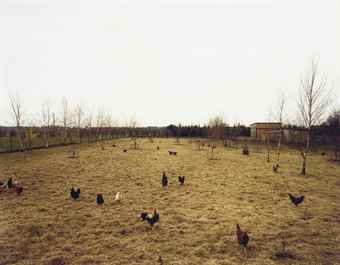 |
| Andreas Gursky, Niagra Falls, 1989 |
Today was my German day in London. I saw the first of two
Andreas Gursky exhibitions and visited Christie’s new exhibition space on New
Bond Street which is showing Polke/Richter-Richter/Polke.
I found Andreas Gursky. Early Landscapes
at Sprüth Magers in Grafton Street to be fascinating, but I am not sure that
everyone will be as captivated. I was excited because they are all
photographs I know well, but have never seen.
 |
| Andreas Gursky, Alba, 1989 |
Niagra Falls
(1989) on the wall opposite the entrance takes over the upstairs gallery with
its visual complexity. The press release makes a lot of the boat heading into
the abyss of the renowned waterfalls, the impossibility of the tourists’
survival, and the simultaneous fact that they must survive. The blurb also mentions the characteristic Gursky dwarfing of human life by the
immensity and power of a natural, sublime landscape. However, to my eye, the most
interesting moment, or moments in Gursky’s photograph, come in the form of two
black birds that rupture the whited out sky above the falls. The birds are like
stains on the image, troubling because they are distinct, free and autonomous,
none of which can be said about the boatload of tourists. The two
birds disturb because they are what Roland Barthes has taught us to recognize as the
punctum, the moment when all rationality collapses. Certainly, for me, the birds
signify the photographic gesture that ensures we can no longer hold on to
familiar distinctions. The viewer's being forced to navigate such unsettling gestures is what makes Gursky's photographs provocative.
 |
| Andreas Gursky, Mettmann, Autobahn, 1993 |
I have always maintained that Gursky's photographs must be
seen in the flesh. Mettmann, Autobahn,
1993 is a perfect example, because the slats or strips that striate the image
in reproduction appear painted on afterwards. Up close to the photograph
itself, even in digital reprint, we see that the strips are before the camera,
apparently painted on a perspex noise barrier along the autobahn. And when up close, once again, what disturbs is not what we might imagine. It is not the strips that
challenge the viewer, but the cows who disquiet the wholeness of the landscape just like the
birds in the sky of Niagra Falls. It’s
difficult to pinpoint why or how they disrupt, but unlike the chickens in Krefeld. Hühner 1989, the cows are not
the subject of the photograph, and yet, they are its only life energy, and
therefore, draw our attention.
 |
| Andreas Gursky, Ofenpass, 1994 |
In Ofenpass, 1994
we see Gursky already begin to push the representational into abstraction. It's
an image that in its blown up version looks forward to the more recent
works. The verticality of the image, the lack of distinction between mountain
and sky, the importance of landsape as a subject and object, the impossible
perspective that looks both from a position perpendicular to and overhead at the mountain; all are characteristic of the later photographs. Like the later works, this landscape is made strange. It is flattened out, creating a
verticality to the image which is unusual for photography, especially landscape
photography. The flatness is both Gursky’s departure from the Romantic
composition of his vision, as well as the underlining of the same tradition to
which he owes his greatest achievements.
 |
| Andreas Gursky, Hühner, Krefeld, 1989 |
Perhaps the most fascinating question raised by this
exhibition is that of reproduction. As he often does, Gursky has reprinted images for this exhibition. Not only are the photographs reprinted, but
they are blown up to the oversized dimensions of the contemporary Gursky
digital prints. These dimensions are so unusual for photography that I kept
wondering what has happened to photography in Gursky's photographs. As if it is not enough to change
the size of the prints, Gursky has also remounted the prints in a process known
as diasec which permanently fuses acrylic glass and the C-print. Gursky’s work
from the late 1980s is known to be unstable, vulnerable to deterioration and
colour fading because he used the materials of chromogenic photography before
they were fully established. Exposed to
light, humidity, and temperature fluctuations, Gursky’s prints from this period
have continued to undergo chemical reactions, creating havoc for collectors and
dilemmas for the market. It’s not clear if the instability of the 1980s and early 90s
prints inspired Gursky to reprint for aesthetic, economic or practical reasons.
However, the end result is the same, the question must be asked: what are we
looking at? Do we look at the original photographs? A transformed image? And
what does this transformation do to the meaning of the image? These are
anything but works from 25 years ago. The photographs exhibited at Sprüth
Magers have no physical history, and a history of aesthetic and hermeneutic
transformation, from analogue to digital, transformation of dimensions,
material, offering new challenges to viewers and critics alike. If photography was once the infinitely reproducible image, evoking repetition, seriality and loss of originality, then it becomes a very different medium and process of production in Gursky's studio.





No comments:
Post a Comment